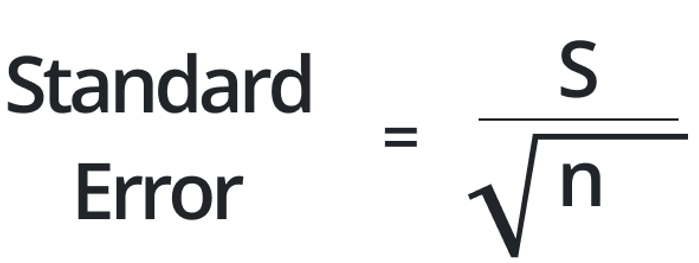To calculate result you have to disable your ad blocker first.
Standard Error Calculator
Enter raw or summary data and hit the calculate button to find standard error
Standard Error Calculator
Standard Error Calculator is used to determine the standard error of the group data or sample data using the standard deviation and sample size.
What is Standard Error?
The standard error is a statistical term that measures the variability or uncertainty in the estimates or measurements of a statistical sample variation. In simple terms, standard error quantifies the average amount of variation or error we can expect in the estimate of a population parameter based on a sample.
It provides an indication of how reliable the sample statistic is in representing the population parameters estimation. It measures the precision or dispersion of the sample statistic with the true population parameter.
The standard error in numerical form is calculated using the standard deviation of the sample data and the sample size. It is simply denoted as “SE”.
The formula for Standard Error
The formula of standard error in mathematical form is stated below.
Standard Error (SE) = (Standard Deviation of the Sample) / √Sample Size

Where,
- σ = Standard deviation,
- n = Sample Size
Steps to calculate standard error?
It is calculated, by dividing the standard deviation of the data set by the square root of the sample size of data. Here are the steps to calculate:
First, collect the data and arrange it in descending order.
Find the sample mean of data, by dividing the sum of all data by the number of elements.
Calculate the standard deviation of given data using the formula of standard deviation.
Note the sample size of the given data set.
Divide the standard deviation value with the square root of the sample size and get the standard error results after simplification.
Alternatively, use the above Standard Error calculator to calculate the standard error value by simply inputting the values in the given tabs and getting results in seconds.
How to find the numerical value of Standard Error?
Example 1:
If the sample size of statistical data is 5 and the sample data is 34, 12, 13, 15, and 10 then find the Standard error.
Solution:
Step 1: Write the data from the given sample data.
Input Data = {34, 12, 13, 15, 10}, sample size = n = 5
Step 2: Write the formula of the Standard error.
Standard error = σ/√n
Step 3: Write the formula of Standard deviation.
STD (σ) = √(∑ (x - x̄)2/n – 1)
Step 4: Using the formula of mean find the standard error.
x̄ = (Sum of all Values Number of values)/sample size
x̄ = (34+12+13+15+105)/5
x̄ = 845/5
x̄ = 16.8
∑(x - x̄)2 = ( 34 - 16.8 )2 + ( 12 - 16.8 )2 + ( 13 - 16.8 )2 + ( 15 - 16.8 )2 + ( 10 - 16.8 )2
∑ (x-x̄)2 = (17.2)2 + (4.8)2 + (3.8)2 + (1.8)2 + (-6.8)2
∑ (x - x̄)2 = 382.8
Step 5: Put the value in the formula of “Step 3” and simplify.
STD (σ) = √{(∑ (x - x̄)2)/(n – 1)}
= √ {382.8/(5 – 1)}
= √ {382.8/4}
= √ 95.7
STD (σ) = 9.78264
Step 6: Finally, put the above values in the Standard error formula.
SE = 9.78264/√5
SE = 4.37493
Example 2:
If the standard deviation is 56 and the sample size is 6 then find the standard error.
Solution:
Step 1: Write the data from the above conditions.
σ = 56, n = 6.
Step 2: Write the formula of standard error.
SE = σ/√n
Step 3: Put the values in the above formula.
Standard error (SE) = 56/√5
SE = 22.8619
Frequently Asked Questions (Faq’s)
What is meant by Standard Error?
Standard error is the approximate value of the standard deviation for the sample size of the data set. It represents the variability or spread of the sample mean with respect to the population mean of the data set.
What’s the difference between standard error and standard deviation?
Standard error (SE) and Standard deviation (SD) both are measures of variability but differ due to their variation sampling size.
SD measures variation for a single sample that tells us how much the data are dispersed or scattered around its mean value.
SE measures variability for multiple samples of the population which tells us the variability of the sample mean across its population mean.
What is the standard error of the mean (SEM)?
The standard error of the mean is the measure of variability and tells us how the population mean differs from its sample mean. It indicates how much the sample mean varies from its new sample data under a single population. SEM simply says that the standard error (SE).
Is SE same as the SEM (standard error of the mean)?
Yes, both are the same terms and uses for the measure of the variation of the sample mean. If the use of statistics is the sample mean for the solution of SE then the Standard error (SE) becomes the standard error of the mean (SEM).
What is the relationship between Standard Error and Sample Size?
The standard error is inversely proportional to the sample size of the data. This means if the size is too small then the SE is large or vice versa. The larger value of the SE means that the sample mean of your data is widely spread around your population which gives less statistics results.

